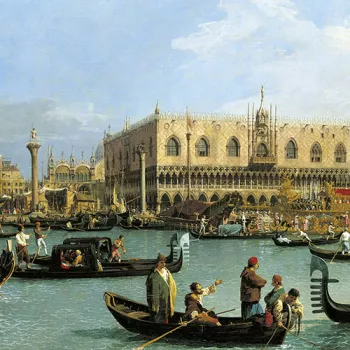Capriccio View of the Piazzetta with the Horses of San Marco c. 1743-4
Oil on canvas | 108.0 x 129.9 cm (support, canvas/panel/stretcher external) | RCIN 404414
-
When the Venetians took Constantinople in 1204 during the Fourth Crusade, they brought back important artefacts to Venice, including four magnificent gilt-bronze Greek or Roman horses. These were installed above the central arch of the west façade of San Marco, the focal point of Venetian life, as symbols of the power of Venice and Venetian pride. Their removal to Paris by Napoleon in 1798 was therefore devastating; they were eventually returned in 1815.
Canaletto has taken down the horses from San Marco and placed them on high pedestals in front of the Basilica. Among the visitors studying the horses is a group of Procurators and Senators on the right, gazing up at them in awe. The dating takes an unusual form. The nearest pedestal has the Latin inscription, "A B VRB. COND. MCCCXXXII", above and below the Grimani arms under the ducal cap. Pietro Grimani reigned as Doge from June 1741 to March 1752. The inscription states that the date is 1,332 years after the foundation of Venice, which traditionally took place in AD 421. The date of the painting would therefore be 1753, which is after Grimani's death and nine years after the rest of the series. It has been plausibly suggested that Canaletto added a third X in error, which would make the date 1743. If this X was intended to be a I, the date would be 1744, which matches the date of the rest of the paintings in this series of 13 overdoors commissioned from Canaletto by Consul Joseph Smith. This use of the date of the foundation of Venice both emphasises the signifiance of the horses and links the Venetian Republic with ancient Rome.
The bas-reliefs on the two inner pedestals probably allude to the taking of Constantinople in 1204. Not only are the horses ancient Greek or Roman, but they have always been associated with Roman triumphal arches. The central entrance to San Marco architecturally forms its own triumphal arch, so here the horses symbolised the invincibility of Venice, powerful successor of the Roman Empire. When they were moved to Paris they were eventually placed on the Arc du Carrousel, which honoured Napoleon's triumphs.
Perhaps Canaletto's removal of the horses from their position of honour had a deeper and more politically significant meaning, undermining the myth that Venice was the legitimate successor of Rome. Yet their arrangement in the Piazza had the advantage of allowing the horses to be presented and admired as works of art. Consul Smith may have known Enea Vico's publication Discorsi sopra le medalglie de gli antichi (Venice 1555), in which the author suggests giving the horses more space and dignity by moving them to high pedestals in beautiful marble in the Piazza. Smith would certainly have known Anton Maria Zanetti's two-volume publication in 1740, Delle antiche statue grecche e romane, since he obtained the rights to publish the book. Here each horse was given its own plate, reproduced in careful detail. Thus both Canaletto and Zanetti were concurrently awarding these bronzes the status of individual works of art.
Signed at the lower left: ACANAL Fe.
Text adapted from Canaletto & the Art of Venice, 2017.Provenance
Acquired by George III from the collection of Consul Smith in 1762 (Italian List no 96); recorded in the Old Dining Room in Buckingham Palace in 1819 (no 828)
-
Medium and techniques
Oil on canvas
Measurements
108.0 x 129.9 cm (support, canvas/panel/stretcher external)
128.5 x 152.0 x 13.0 cm (frame, external)
Category
Object type(s)
Other number(s)
Alternative title(s)
View of the Piazzetta with the Horses of S. Marco









